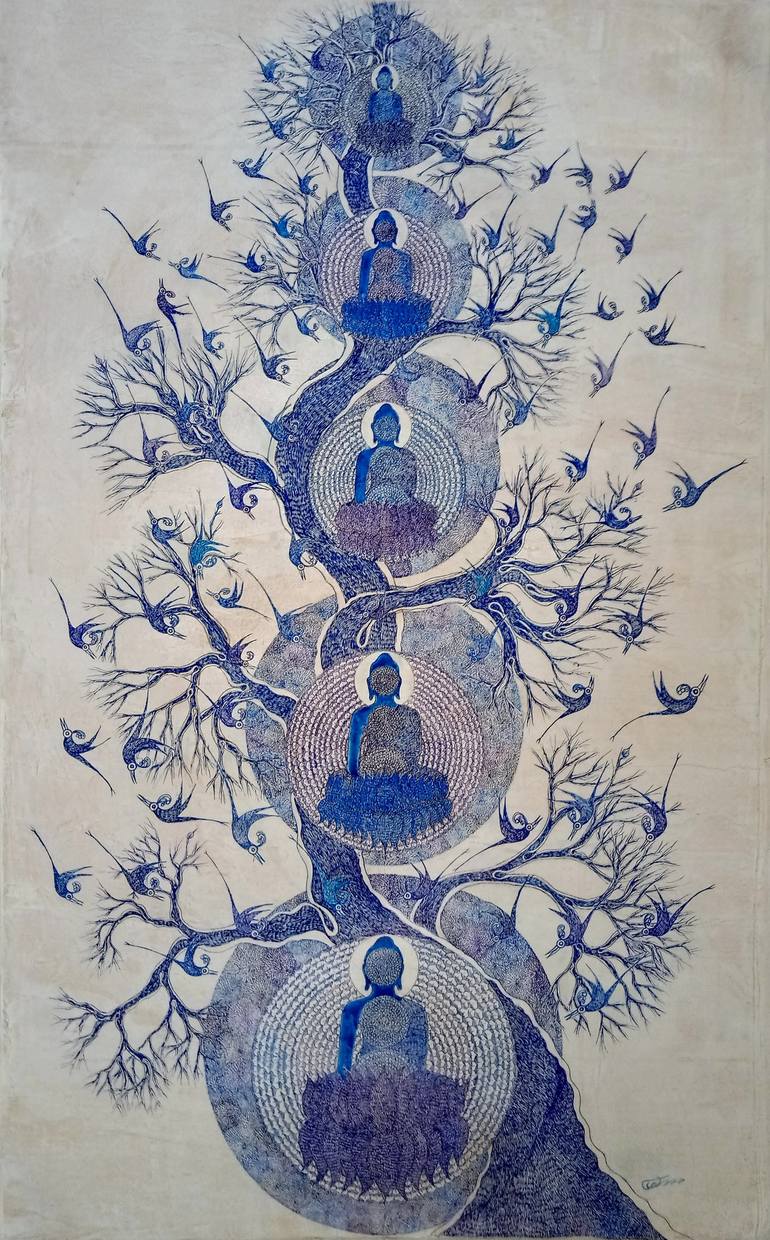


VIEW IN MY ROOM
TREE OF ENLIGHTENMENT Painting
India
Painting, Acrylic on Canvas
Size: 30 W x 48 H x 0.1 D in
Ships in a Tube
About The Artwork
THE TREE OF ENLIGHTENMENT Just before the full moon day of the month of Vesakha in about the year 528 BCE, a young ascetic of noble birth, worn out by years of self denial, arrived on the outskirts of the small village of Uruvela nestled on the banks of the sandy Neranjara River. He settled himself under the spreading branches of the a nearby tree and prepared to begin his meditation.. All night he sat there as the leaves of the tree quivered in the gentle breeze and the moon shone bright in the velvety black sky. Eventually the clouds of ignorance dissolved and he saw the Truth in all its glory and splendor. He was no longer Prince Siddhartha or the ascetic Gautama. The Buddha spent the next seven weeks near Uruvela experiencing the bliss of enlightenment and moving to a different location every seven days. There is no evidence that the Buddha ever returned to Uruvela. But as his teachings spread and attracted more followers some of these people began to want to see the place where their teacher had attained enlightenment. Understanding that this could arouse faith or further nourish faith already aroused, the Buddha encouraged such visits. Thus the Buddhist tradition of pilgrimage began. By the 2nd century BCE the name Uruvela fallen into abeyance and the village came to be known as either Sambodhi, Vajrasana or Mahabodhi. The name Bodh Gaya only came into use in the 18th century. Artist’s Statement – Bodhiselvam Unending quest for Buddhist’s preaching’s and philosophy artist Bodhiselvam set out to Uruvela to personally experience the path of Buddha.He travelled the same path and came to understand that Buddha meditated without sleep and wandered for seven days, walking about in and around Uruvela.. Later he was seen in and around the area, now called Bodhgaya for 21 days. This singular state of mind, in complete meditation, a state of nothingness, attracted Bodhi to experience the same within the limits of the mortal body. Subothi – Dialogue in Buddhism "The practice of dialogue expresses a central tenet of Buddhism--faith in human beings, in their limitless dignity and potential as possessors and embodiments of universal truth. In the Buddhist tradition, dialogue--open and respect-based human interaction--has played a central part in the quest to discover and identify common or universal values that would allow human beings to live in the best, most humane and empowering ways."
Details & Dimensions
Painting:Acrylic on Canvas
Original:One-of-a-kind Artwork
Size:30 W x 48 H x 0.1 D in
Frame:Not Framed
Ready to Hang:Not applicable
Packaging:Ships Rolled in a Tube
Shipping & Returns
Delivery Time:Typically 5-7 business days for domestic shipments, 10-14 business days for international shipments.
Handling:Ships rolled in a tube. Artists are responsible for packaging and adhering to Saatchi Art’s packaging guidelines.
Ships From:India.
Customs:Shipments from India may experience delays due to country's regulations for exporting valuable artworks.
Have additional questions?
Please visit our help section or contact us.
India
Bodhiselvam 25-October-1969 Kanchipuram, Tamilnadu. Buddha paintings, Mr. Bodhiselvam, who has given a new dimension to our conceptions of Buddha and explored the unchartered terrains in the Buddhist enlightenment. How Buddha would have looked like? The painter’s lines and dots provide an answer to this mystic question. Why has he chosen Buddha as the pivotal force for his portraits? The way Siddhartha in the third century B.C shed his cozy and comfortable princely life and set out to get at the root of answers to some mysterious questions about life, struggle and death has charmed Mr. Bodhiselvam. The spell is so deep and everlasting that he set out to identify his life and outlook with Buddhist teachings and also draw up portraits of Buddha in His state of nirvana. His paintings dexterously recapture the very moment of Buddha’s enlightenment, the ‘sambodhi’ moment as he calls it. He says about how he was captivated by His journey towards the roots of the universe. Disrobing himself of the royal comfort, he went out in search of the roots. Initially meeting five saints or sanyasins, he undertook a severe and austere penance, subjecting himself to a rigorous schedule of denial, forgoing food and water for years together. He was abandoned by His own men and yet He pursued his goal of enlightenment. Finally when He attained the most previous ‘gnanam’ or the state of nirvana, the roots of the universe such the expansive and elegant skies, sparkling stars, mesmeric and mysterious moon, winged winds, swinging plants, creepers and all brings buzzing with beauty got into His head. Around Buddha’s new head shone a halo, holy and blissful. It is this rarest of rare moment that has permeated Mr. Bodhiselvam’ s paintings. The traditional image of Buddha cannot be seen in his works. The portraits of Lord Buddha’s head over which the plants hang and His face exuding an air of the great enlightenment bring back alive Buddha in his magic moment of enlightenment from the archives of centuries. Like Buddha who did not have any guru or teacher in his spiritual journey, Mr. Bodhiselvam too did not have teacher to learn from. His painting style is absolutely self-made in the sense that as he is a self-made painter, he says that his portraits draw themselves. The moment he drew up Buddha’s head with a bamboo stick dipped in black, the rest of the features automatically came alive into the picture.
Thousands Of Five-Star Reviews
We deliver world-class customer service to all of our art buyers.
Global Selection
Explore an unparalleled artwork selection by artists from around the world.
Satisfaction Guaranteed
Our 14-day satisfaction guarantee allows you to buy with confidence.
Support An Artist With Every Purchase
We pay our artists more on every sale than other galleries.
Need More Help?